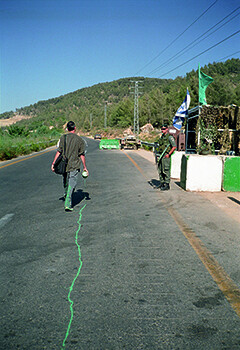February 8–May 3, 2015
Weatherspoon Art Museum
University of North Carolina at Greensboro
500 Tate Street
Greensboro, NC 27402
The Weatherspoon Art Museum at The University of North Carolina at Greensboro is pleased to present Zones of Contention: After the Green Line (February 8–May 3), an exhibition of artworks that examine historical and contemporary aspects of the decades-long conflict between Israel and Palestine. Through photography, video, collage and sculpture, the exhibition addresses some of the complexities of social, personal and cultural life in this region of the world. Artists participating in the exhibition include Francis Alÿs (Belgium/Mexico), Yael Bartana (Israel), Dor Guez (Jaffa), Wafa Hourani (Palestine), Nira Pereg (Israel), Michael Rakowitz (USA), and Sharif Waked (Palestine/Israel).
The exhibition is the second in a series of curatorial projects organized by Xandra Eden that demonstrate ways by which contemporary art and artists can create a platform to discuss circumstances around the globe and their impact upon local and regional communities. The first Zones project, which took place in 2012, focused on artists and community members who explored issues related to the US/Mexico border. After the Green Line is similarly inspired, and through its public programs, examines the significance of the issues addressed by the artists to the local community.
After the Green Line focuses on the effects and consequences of this long conflict upon everyday life. Artworks include Francis Alys’s SOMETIMES DOING SOMETHING POETIC CAN BECOME POLITICAL AND SOMETIMES DOING SOMETHING POLITICAL CAN BECOME POETIC (2007), a video in which the artist carries a dripping can of green paint along the Green Line, the armistice boundary marked on a map in 1949 to end the Arab-Israeli War; Yael Bartana’s A Declaration (2006), which examines the changing symbolism of the olive tree within the current context; and Dor Guez’s (Sa)Mira (2009), which grapples with the discrimination felt by some Israeli citizens of Arab descent. Wafa Hourani’s Pan of Qalandia (2014) imagines a section of the largest checkpoint between Jerusalem and Ramallah, while Nira Pe reg’s Sabbath (2008) documents the closing off of ultra-Orthodox neighborhoods in and around Jerusalem on the eve of Shabbat. Other works include Michael Rakowitz’s multi-media installation, The Breakup (2012), which conflates the break-up of the Beatles in London with the breakdown of Middle Eastern relations that led to the Six Days War in 1967; and Sharif Waked’s video, Bath Time (2012), which uses humor to point to the many absurd situations spawned by the ongoing conflict.
The exhibition is accompanied by a series of artist talks, film screenings, tours, a gallery guide, and a small library of information that will provide context for the artwork and the artists’ process. The project is produced in dialogue with the Zone Team, a group consisting of local artists, community leaders, museum board members, and university faculty and students, who have helped to develop effective ways to position the content of the exhibition and accompanying issues for Weatherspoon audiences.
Zones of Contention: After the Green Line is organized by Xandra Eden, Curator of Exhibitions; with the assistance of Terri Dowell-Dennis, Associate Curator of Education; Jordan Rossi, Graduate Student, UNCG History/Museum Studies program; Carmen Neely, Graduate Student, UNCG Art Department; and members of the Zone Team who so generously donated their time and expertise. The project is made possible through the support of the National Endowment for the Arts, the North Carolina Arts Council, the Artis Grant Program, and the Rotary Club of Greensboro.
For additional information on related programs, visit the museum’s website.
*Francis Alÿs, SOMETIMES DOING SOMETHING POETIC CAN BECOME POLITICAL AND SOMETIMES DOING SOMETHING POLITICAL CAN BECOME POETIC, 2007. Documentation of an action, produced in collaboration with Julien Devaux. Collection of the Los Angeles County Museum of Art. Image courtesy of the artist. Photo: Rachel Leah Jones.


